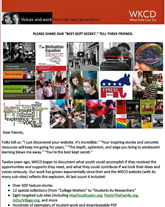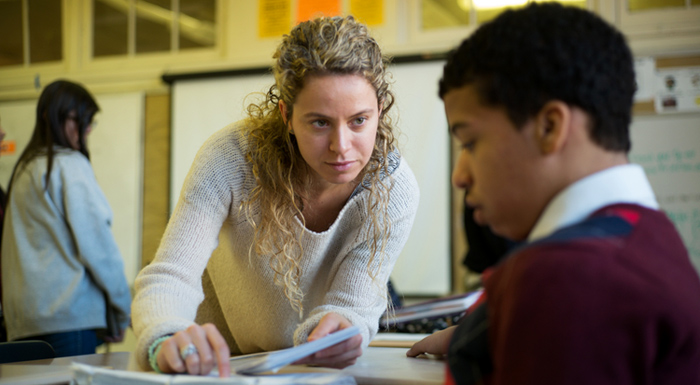OTHER WKCD WEBSITES SPECIAL COLLECTIONS Students as Allies in School POPULAR WKCD PUBLICATIONS (PDFS] A Guide to Creating Teen- Cultural Conversations through Creative Writing Documenting Immigration Stories First Ask, Then Listen: How Your Students Can Help You Teach Them Better Making Writing Essential to Profiles of Politically Active Youth Queer Youth Advice for Educators The Schools We Need: Creating Small High Schools That Work for Us
| Student-Centered Learning and the Roles Teachers Play by BARBARA CERVONE and KATHLEEN CUSHMAN | SEPTEMBER 23, 2014
Photo by Andrew Reed Weller "I don’t think we have clearly defined roles here. We wear so many hats, we do so many different things. So if you’re the kind of teacher that wants to just come in and teach your curriculum, this is not the place for you." - Janice Eldridge, teacher, Noble High School, South Berwick, ME "Who do I want my teachers to be? First of all: teacher, professor. Then there’s friend: most of the time, the teachers here create a very personal relationship with their students. They get involved in what their students care about, they help them and coach them. Finally, there’s mentor: beyond that personal relationship with kids, the teachers here also help you discover how to succeed in what interests you. They are examples of that." - Morgan, student, Noble High School In WKCD's recent documentation of American high schools that prize student-centered learning, we identified six core teaching practices. We also examined the complex roles teachers played in these schools. We were reminded, again and again, that schools do not rise or fall—and students do not thrive or fail—based on structures and practices alone. Institutions and students alike depend on the ability of teachers, in the course of any day, to take on a range of roles. In the case of student-centered learning environments, these roles include curriculum planner, classroom facilitator and coach, assessor, adviser, connector, and communicator. Teachers in the schools we studied will tell you that wearing so many hats is at once challenging and invigorating. Our study schools, all selected because of their long and successful track record putting students at the center, included: Alief Early College High School in Alief, Texas; Bronx International High School in Bronx, New York; Dayton Early College Academy in Dayton, Ohio; MetWest, Oakland, California; NYC iSchool in New York City; and Noble High School in North Berwick, Maine. (Learn more about these schools.)
Curriculum planner For the teachers we observed in these six secondary schools, planning curriculum was a constant aspect of their work. Most set aside textbooks, instead calling on multiple sources for ideas and materials, and choosing depth over “coverage.” Peggy Breef, a teacher at Alief Early College High School explained her rationale:
Courses at NYC iSchool are largely shorter and quite focused, presenting particular challenges for teachers who plan curriculum. “The first year I created at least five separate courses that I had never taught before,” said veteran science teacher Susan Herzog. To complicate things further, iSchool courses take several forms: challenge-based modules that address problems in the outside world, online instruction to master traditional material tested on state exams, and core academic seminars and labs. Each requires its own kind of preparation, but certain elements remain central, said Alisa Berger, the principal at the time of our study.
Teachers in the schools we visited planned curriculum with colleagues wherever possible, both devising and continually revising their lessons. Many went to great lengths to integrate curriculum across disciplines, as Josh Gould at Noble High School described:
Classroom facilitator and coach Once in their learning environment with students, teachers in these schools acted more as guides than lecturers. It worked best, they said, if they set up scenarios in which students could explore, ask their own questions, and discover their own answers. “When I’m in the classroom, I don’t feel like I’m a teacher,” mused Bronx International English teacher Dolan Morgan:
Teachers in the Early College High School initiative, including those at Alief ECHS and Dayton Early College Academy (DECA), follow an instructional framework containing six strategies: collaborative group work, “write to learn,” classroom talk, questioning, scaffolding, and literacy groups. Each strategy places the teacher squarely in the role of facilitator, Alief’s Peggy Breef noted, and the AVID curriculum further reinforces that:
We watched one class in an NYC iSchool science module, whose challenge was to create a green roof for the school. At its start, Susan Herzog loosely framed what lay ahead for her students, leaving ample room for their own initiative. They would go up to the roof a couple times a week to see what the shadows look like at different times a day, she explained. Then they would answer: How can we put a classroom up there? What kind of materials would we use to build it? Where would we site the panels, solar panels, wind turbines, etc.? Assessor The teachers we observed in these schools regarded assessment as a student-centered art, continually interwoven with the business of teaching. More than just a test, such assessment is an active process that requires teachers to stay alert to countless signals, said NYC iSchool principal Alisa Berger. As they circulate the class, they engage with every student in some way where they can measure their understanding. For iSchool courses conducted primarily online, Berger noted, the teacher plays an equally important assessment role:
Dolan Morgan likes the specificity of Bronx International’s outcomes-based assessment system, which breaks out skills and content that students master at their own pace. Even what students choose not to work on, Morgan said, gives him useful information on what to do next:
At all of our six schools, students had high-stakes state tests looming, and although those often lacked the emphasis on deeper learning that teachers preferred, they could not be ignored. As the Texas Assessment of Knowledge and Skills (TAKS) approached, Alief’s Peggy Breef found a balance that worked for her students:
The assessment data that most helped teachers improve their teaching, we heard again and again, was closest to home: “what’s happening with our students.” Adviser Though not all the schools we visited structured student advisement in the same way, all the teachers in this study saw the adviser role as central to their work. “A lot of the students struggle here with getting support from home or other places,” noted teacher Jessica Austin at DECA, where students remain in one advisory group for grades 7 and 8, then move to another for the high school years. Austin considers the advisory relationship critical to their success, both emotionally and academically, she said:
Teachers do acknowledge that the advisory role adds extra responsibilities to their full plates, and these six schools take pains to keep advisement structures from becoming a perfunctory chore. Alief ECHS locates academic advisement in its AVID classes; in a separate system, each adult mentors twelve students one-to-one. At NYC iSchool, too, every adult shares in advisory responsibilities. “We create a culture that every adult in the school is a teacher, and that’s through advisory,” said NYC iSchool principal Alisa Berger. “That is an inherent part of this model: we’re all learning and we all work together.” Noble High School disbanded its advisory groups to embed advisement in familial team structures, where four teachers and a guidance counselor work closely with 80 students. Counselor Shirley Lajoie said the new system works well for both students and teachers:
Connector The interpersonal networks in which adolescents participate make a big difference to their future lives, research shows (Putnam, 2004; Schaefer-McDaniel, 2004; Lee and Croninger, 1999). At Bronx International, for example, helping students connect with summer opportunities or post-secondary pathways is a frequent focus of group discussions, said one tenth grader:
In rural Maine as well, opportunities can be scarce for teenagers, especially during hard economic times. “I am constantly sending out opportunities via email for summer programs, or scholarship opportunities, or contests that they can enter,” said teacher Adina Hunter. “That’s a lot of what I do: connect students to opportunities to push themselves, above and beyond their classrooms.” MetWest teacher-advisers often mine their personal networks to connect students with potential community mentors for the internship curriculum at the school. More, they explicitly teach students the skills to reach out on their own behalf. Cameron described his ninth grade practice sessions at MetWest, making calls to seek an internship placement:
What Kids Can Do, Inc. | info@whatkidscando.org | www.whatkidscando.org
|



